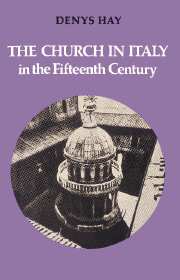Book contents
- Frontmatter
- Contents
- PREFACE
- 1 The problems of Italian church history
- 2 Diocesan and parochial organisation
- 3 The Schism in Italy: the emergence of an Italian papacy
- 4 The state of the clergy and laity in fifteenth-century Italy
- 5 The quality of Italian religious life. Reform
- 6 The Italian Renaissance and the clergy of Italy in the fifteenth century
- APPENDIX
- NOTES
- REFERENCES
- INDEX (NOT INCLUDING APPENDICES)
6 - The Italian Renaissance and the clergy of Italy in the fifteenth century
Published online by Cambridge University Press: 22 October 2009
- Frontmatter
- Contents
- PREFACE
- 1 The problems of Italian church history
- 2 Diocesan and parochial organisation
- 3 The Schism in Italy: the emergence of an Italian papacy
- 4 The state of the clergy and laity in fifteenth-century Italy
- 5 The quality of Italian religious life. Reform
- 6 The Italian Renaissance and the clergy of Italy in the fifteenth century
- APPENDIX
- NOTES
- REFERENCES
- INDEX (NOT INCLUDING APPENDICES)
Summary
The sketch given above of the Italian church and clergy was intended initially as a preparation for an examination of some of the problems posed by the emergence in Italy of novel artistic, educational and moral programmes in the decades at the end of the fourteenth and the beginning of the fifteenth century. The intention was to find answers to the questions: what did the Italian clergy make of the Renaissance? What did the Renaissance make of the clergy in Italy?
The debate about religion and its relations with the Renaissance
These are not new questions as such. Indeed the old writers were convinced that there was a simple answer, though they were not entirely agreed on what the answer was. For Burckhardt the Renaissance was the exciting if painful moment when modern man was born. And modern man was a creature of little faith; there was a strain of scepticism about the Italian humanists and their patrons which was to grow in the centuries ahead. Only a few years later Pastor took up the same theme and accepted Burckhardt's thesis – subtly expressed as it had been – treating it as a confirmation of the existence of a ‘pagan’ renaissance. Alongside this Pastor drew his reader's attention to the Christian renaissance – in which the artists and scholars of the quattrocento were displayed devoting their talents to the service of God, or at any rate to the service of the clergy.
- Type
- Chapter
- Information
- The Church in Italy in the Fifteenth CenturyThe Birkbeck Lectures 1971, pp. 91 - 109Publisher: Cambridge University PressPrint publication year: 1977



